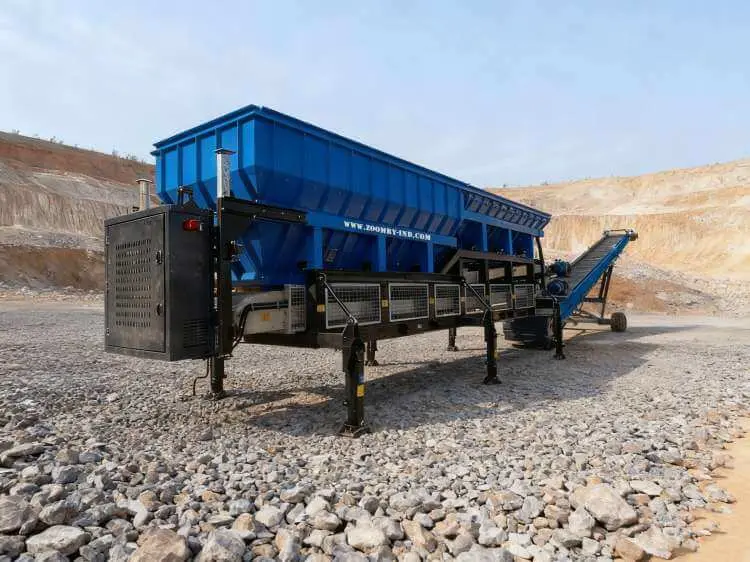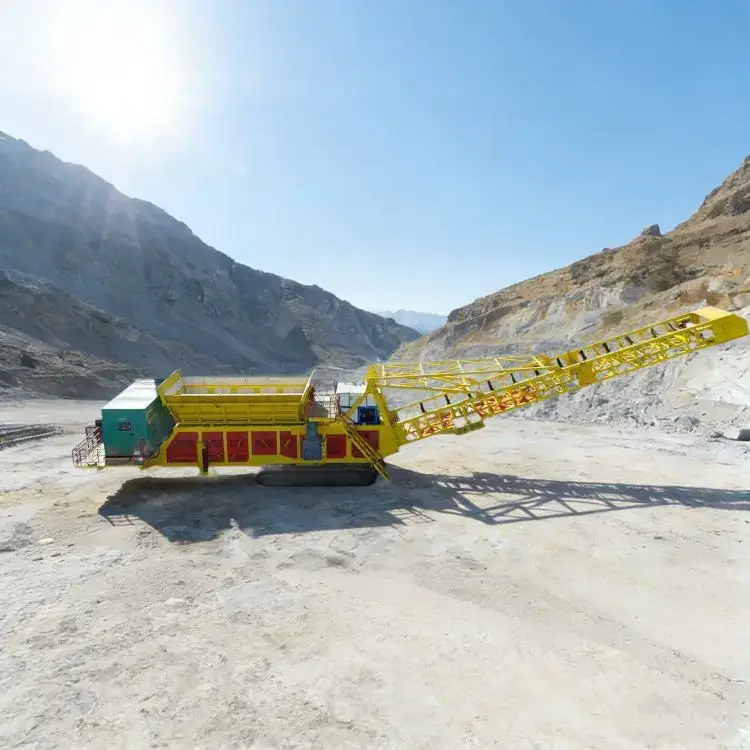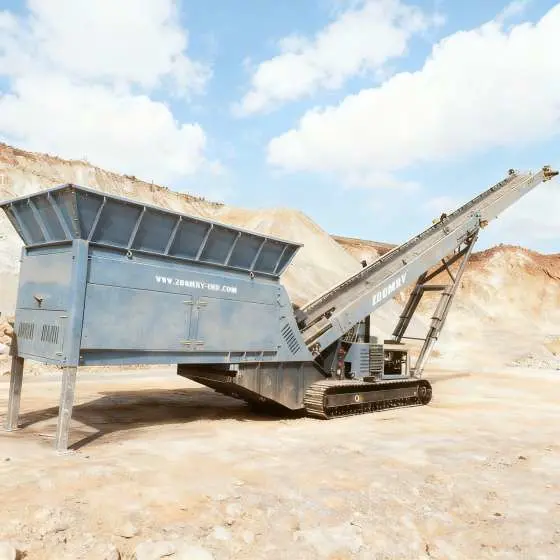ZOOMRY Static Hopper Feeder is a static and high-efficiency feeding equipment specially designed for global bulk material handling scenarios. It belongs to ZOOMRY's bulk material conveying equipment family and can seamlessly connect front-end feeding equipment (wheel loaders, grab cranes, excavators) with back-end conveying/processing equipment (belt conveyors, telescopic stackers, mobile ship loaders, truck unloaders). It is a key core equipment that links the entire process of "feeding - conveying - processing".
The equipment adopts the core design concept of "static feeding". The hopper capacity ranges from 5 to 15 m³ (horizontal stacking), with a maximum capacity of up to 1000 tons per hour (TPH). It supports the "front-end equipment direct feeding and discharging" mode, which can completely eliminate secondary material handling. At the same time, it is compatible with two installation methods: fixed and wheeled. It can handle various bulk materials such as sand, aggregates, ores, cement clinker, and coal. It not only meets the long-term fixed operation needs of quarries, ports, mines, building material factories and other scenarios, but also adapts to the flexible adjustment of temporary material transfer. Currently, it has served customers in more than 50 countries and regions around the world, and has become a core supporting equipment for ZOOMRY's belt conveyors, scraper feeders and other products, providing integrated bulk material handling solutions for domestic and foreign customers.

Core Advantages of Static Hopper Feeder
Eliminates Secondary Material Handling
In traditional bulk material handling, wheel loaders are required to first stack materials into temporary piles and then transfer them to conveying equipment. This process is not only time-consuming, but also causes 10%-15% of aggregate crushing loss due to material collision. ZOOMRY Static Hopper Feeder supports the "front-end equipment direct feeding" mode - wheel loaders, grab cranes and excavators can discharge materials directly into the hopper. The materials are smoothly conveyed to back-end equipment (such as belt conveyors) through the static feeding system, eliminating the temporary stacking link. The comprehensive operation efficiency is increased by more than 40%, while reducing material loss and labor input.
High Capacity of 1000 TPH
For scenarios with "high productivity requirements" such as ports and large quarries, the maximum capacity of the equipment can reach 1000 tons per hour (TPH). Moreover, it realizes "controllable feeding" through the frequency conversion drive system - the feeding speed can be accurately adjusted (stepless adjustment from 0 to 1000 TPH) according to the capacity of back-end belt conveyors and telescopic stackers. This avoids equipment blockage caused by excessive feeding speed or idleness of back-end equipment caused by too slow feeding speed. For example, in port ore loading operations, it can synchronously match the loading speed of mobile ship loaders to ensure seamless connection of the entire process of "feeding - conveying - loading".
Flexible Hopper Capacity of 5-15 m³
The hopper capacity of the equipment ranges from 5 to 15 cubic meters (horizontal stacking). The capacity can be increased to 6.3-18 cubic meters in the stacked state (based on the material bulk density of 1.6 tons/cubic meter). It can be flexibly selected according to the specifications of the customer's feeding equipment: small quarries choose 5-8 cubic meters capacity, which is compatible with 20-30 ton wheel loaders; large ports or mines choose 12-15 cubic meters capacity, which can directly receive full-hopper feeding from large loaders such as CAT 994 or grab cranes without discharging in batches, further improving efficiency.
Static Feeding Design
Different from the complex transmission structure of mobile equipment, the static hopper feeder adopts a "static feeding system" - it uses a high-torque direct-drive motor (electric or hydraulic drive optional) to drive the EP 500 type 3-layer wear-resistant belt (5mm base belt + 1.5mm wear-resistant layer). This reduces the wear of transmission components, lowers the equipment failure rate by more than 60%, and the mean time between failures (MTBF) exceeds 8000 hours. At the same time, the hopper inner lining can be optional 6mm hardened steel or 15mm ULF wear-resistant material. For the wear characteristics of high-strength materials such as ores and granite, the service life is 3 times longer than that of ordinary carbon steel linings.
Dual Installation Modes: Fixed and Wheeled
The equipment supports two installation methods: one is the "fixed sliding frame chassis", which is suitable for long-term fixed scenarios such as port terminals and mine fixed operation areas. It can achieve permanent stable operation after being fixed by bolts; the other is the "height-adjustable wheeled chassis", which is suitable for scenarios such as phased operations in quarries and temporary material transfer. It can quickly adjust the equipment position through wheeled movement without re-pouring the foundation. The installation and commissioning time is shortened to within 24 hours, adapting to the site planning needs of different customers around the world.
Technical Parameters
| Core Parameters | Specification Range | Remarks (Based on Industry General Standards) |
|---|
| Hopper Capacity (Horizontal Stacking) | 5-15 m³ | 500-900mm hopper opening extension section is optional, increasing the stacked capacity by 20%-30% |
| Maximum Capacity | 1000 TPH (Tons Per Hour) | For aggregates, ores and other materials; the capacity for biomass materials can be adjusted adaptively |
| Adaptable Feeding Particle Size | ≤200 mm (Millimeters) | Customizable 300mm large particle size version, suitable for mine coarse aggregate handling |
| Feeder Belt Specification | 1200mm Wide, EP 500 Type, 3-Layer | 5mm base belt + 1.5mm wear-resistant layer, tear-resistant and wear-resistant |
| Drive Method | Single/Dual Motor Direct Drive (Electric/Hydraulic) | Hydraulic drive is suitable for temporary operation scenarios without external power supply |
| Installation Method | Fixed Sliding Frame / Height-Adjustable Wheeled Chassis | The wheeled chassis is equipped with a braking system to ensure stable operation after movement |
| Applicable Materials | Aggregates, Ores, Sand, Cement Clinker, Coal | Not recommended for high-viscosity materials (such as wet clay) |
| Protection Level | IP65 (Electrical Control Part) | Suitable for harsh environments such as high humidity in ports and high dust in quarries |
Note: The above parameters can be customized and adjusted according to the customer's actual needs (such as material characteristics, site size, and back-end equipment specifications). All data have passed ZOOMRY's laboratory simulation tests and on-site verification, and comply with the ISO 9001 quality management system standards.
Product Structure and Function
The structural design of ZOOMRY Static Hopper Feeder starts from the three dimensions of "ease of use, durability, and compatibility". Each component is optimized for bulk material handling scenarios to ensure stable operation of the equipment under different working conditions around the world:
Static Feeding System
The core static feeding system of the static hopper feeder adopts a direct connection structure of "motor - reducer - drive drum", with no redundant transmission links, and the power loss is reduced to less than 5%. At the same time, it is equipped with a variable frequency drive (VSD), which can adjust the feeding speed through the control panel or remote system. For example, in the aggregate classification operation of a quarry, the feeding speed can be reduced from 800 TPH to 500 TPH according to the capacity of the screening equipment to avoid screening blockage; in the port ore transfer, it can synchronously follow the speed of the mobile ship loader to achieve "dynamic matching".
The feeder belt is an EP 500 type 3-layer wear-resistant belt, which not only has a tensile strength of 500 N/mm, but also has good oil resistance and weather resistance. It can be used normally in environments from -20℃ (cold areas) to 60℃ (high-temperature areas). The two sides of the belt are equipped with height-adjustable side skirts, which can effectively prevent material scattering and reduce on-site cleaning workload.
Hopper Structure
The hopper adopts a "U-shaped bottom + wide bell mouth" design: the U-shaped bottom can avoid material accumulation in corners and reduce the risk of blockage; the hopper opening width is 2.5-4 meters (adapted according to capacity), ensuring that the discharge range of wheel loaders and grab cranes is fully covered without frequent adjustment of equipment position. The inner wall of the hopper can be optionally equipped with 6mm hardened steel liners, which can effectively extend the service life of the hopper for high-wear materials such as iron ore and granite; at the same time, the bottom of the hopper is equipped with a "bolt-fixed anti-fall system" to prevent material blocks from damaging the feeding belt and improve equipment safety.
Installation and Adaptation
As the core equipment of ZOOMRY's bulk material handling line, the static hopper feeder can be seamlessly linked with belt conveyors, telescopic stackers, mobile ship loaders, truck unloaders and other products:
- Linkage with belt conveyors: The discharge port of the feeder can be directly connected to the feed port of the belt conveyor. The "feeding - conveying" synchronous start and stop are realized through the communication interlocking device to avoid material accumulation;
- Linkage with telescopic stackers: In the stacking scenario, the feeding speed can be adjusted according to the stacking radius of the telescopic stacker to ensure uniform material piles and maximize the use of stacking space;
- Linkage with truck unloaders: In the mine raw material transfer, the feeder can smoothly convey materials to the truck unloader, reducing the impact of materials on the unloader and extending the service life of the equipment.
Applicable Scenarios
With "high adaptability and high stability", ZOOMRY Static Hopper Feeder has served customers in more than 50 countries and regions around the world. Its core applicable scenarios include:
Quarries
In the aggregate handling process of quarries, the crushed aggregates need to be quickly transported to screening and washing equipment. The traditional method relies on repeated transfer by loaders, which is not only inefficient but also prone to excessive crushing of aggregates. ZOOMRY Static Hopper Feeder is installed between the crusher and the belt conveyor. The loader directly discharges the crushed aggregates into the hopper, and the aggregates are smoothly conveyed to the screening equipment through the static feeding system, realizing "crushing - feeding - screening" in one go. Taking a quarry with a capacity of 1000 TPH as an example, the equipment can replace the transfer work of 2 30-ton wheel loaders, saving more than RMB 1 million in fuel and labor costs annually.
Ports
In the ore and coal loading and unloading operations of port terminals, the discharge volume of grab cranes fluctuates greatly (500-1000 TPH). If directly connected to mobile ship loaders, it is easy to cause blockage or idleness of the ship loaders. The static hopper feeder can act as a "buffer hub". The hopper temporarily stores the materials unloaded by the grab crane, and then supplies materials to the mobile ship loader at a stable speed through the controllable feeding system. For example, in a coal loading project at a port in Southeast Asia, ZOOMRY's static hopper feeder with a 15 m³ capacity can match the full-hopper discharge of a 25-ton grab crane, increasing the loading efficiency by 25% while reducing coal dust scattering.
Mines
In the raw material pretreatment of mines (such as the transfer of iron ore and copper ore), the working environment is harsh (high dust, high humidity), and strict requirements are placed on equipment failure rates. The static design of ZOOMRY Static Hopper Feeder reduces transmission components, and the IP65-grade electrical control box can resist dust and moisture, with a mean time between failures (MTBF) exceeding 8000 hours. In an iron ore project in China, the equipment is installed at the exit of the underground crushing station and operates continuously for 24 hours. The monthly maintenance time is only 2 hours, which is much lower than the industry average of 8 hours.
Building Material Factories
Materials such as cement clinker and sand in building material factories need to be transported to the production line in a fixed proportion. The stability of the feeding speed directly affects the product quality. ZOOMRY Static Hopper Feeder can control the feeding speed error within ±5% through the variable frequency drive. For example, in the cement production line, it can accurately supply materials to the batching machine, ensuring the stable ratio of clinker to gypsum and improving the qualified rate of cement strength.
Why Choose ZOOMRY
Higher Degree of Customization
Most static hopper feeders of international brands are standardized products, with limited adjustment space for parameters such as hopper capacity and belt specifications. ZOOMRY can customize the hopper capacity (5-15 m³), inner lining material (ordinary carbon steel, hardened steel, ULF), drive method (electric, hydraulic) and other aspects according to the customer's material characteristics (such as high-wear ores, viscous sand), feeding equipment specifications (such as small loaders, large grab cranes) and installation site size.
Full-Chain Compatibility
ZOOMRY has a full range of bulk material conveying equipment such as belt conveyors, telescopic stackers and mobile ship loaders. The static hopper feeder can be seamlessly linked with these equipment without additional adaptation interfaces. However, if the equipment of international brands is matched with conveying equipment of other brands, additional customized adapter components are required, which not only increases costs but also may affect the overall efficiency.
Faster Service Response
The price of equipment from international brands is usually 30%-50% higher than that of ZOOMRY, and the spare parts supply cycle is long (2-4 weeks). Relying on the domestic complete supply chain system, ZOOMRY's equipment has more competitive prices. At the same time, it has established a spare parts supply network covering major global markets. Through cooperation with local logistics providers, it can realize spare parts delivery within 72 hours (for major customers in Asia, Europe and the Americas). The technical team provides 24-hour remote fault diagnosis services to minimize equipment downtime.
Customer Support and Service
ZOOMRY always takes "customer needs as the core" and provides customers around the world with full-process services from selection to after-sales. Even without global spare parts warehouses, it can ensure stable operation of equipment through an efficient service system:
Free Selection and Planning
After customers provide the operation scenario (such as quarry/port), material characteristics (such as aggregate/ore) and capacity requirements (such as 500/1000 TPH), ZOOMRY's technical team will provide a customized selection plan through "material simulation test + site layout analysis", including hopper capacity, installation method, drive options, etc., to ensure that the equipment is fully adapted to the customer's actual needs.
Installation Guidance and Training
A detailed installation manual is attached when the equipment is shipped; the technical team can provide remote installation guidance, or send engineers to the site to assist in installation and commissioning according to customer needs (domestic customers arrive within 24 hours, international customers arrive within 72 hours according to flight arrangements). At the same time, it provides equipment operation and daily maintenance training for customer operators to ensure that the personnel can master the equipment use skills proficiently.
Spare Parts Supply and After-Sales Service
ZOOMRY has a large-scale spare parts warehouse in China, with sufficient inventory of common spare parts (such as belts, drive motors, liners); for international customers, through cooperation with local logistics providers, "spare parts pre-positioning warehouses" are established to ensure spare parts delivery within 72 hours. When the equipment fails, the technical team responds within 24 hours and prioritizes solving the problem through video calls and remote diagnosis; if on-site maintenance is required, engineers will arrive at the site as soon as possible to reduce equipment downtime.



